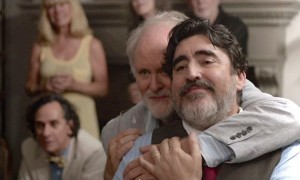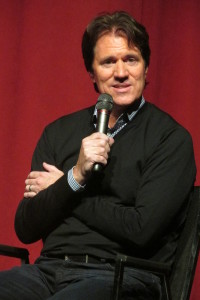Tips on Adaptation and Divisive
Voice-over Devices
by Susan Kouguell
Me and Earl and the Dying Girl opens with protagonist Greg’s line:
GREG GAINES (V.O.)
It was the best of times, it was the worst of times…
Greg Gaines is an awkward high school senior whose mother forces him to spend time with Rachel — his classmate with whom he hasn’t spoken to since kindergarten– who was just diagnosed with cancer.
The beginning of Greg and Rachel’s friendship finds Greg standing at the foot of the stairs in Rachel’s house, and Rachel at the top of the stairs.
RACHEL: Look, I don’t want you hanging out with me. I don’t need your stupid pity. It’s fine. You can just go.
GREG: No, no, hey. You got it all wrong. I’m not here ’cause I pity you. I’m actually here just ’cause my mom is making me.
RACHEL: That’s actually worse.
GREG: Yeah, I know.
RACHEL: Look, it’s OK. Honestly, I’m fine. Just go.
GREG: OK. Rachel, just listen to me for a second. My mom is going to turn my life into a living hell if I don’t hang out with you. OK, I can’t overstate how annoying she’s being about this. She’s basically like the Lebron James of nagging. Lebron James plays basketball.
RACHEL: I know who Lebron James is.
GREG: OK.
Greg tries to blend in as anonymously as possible, avoiding deeper relationships as a survival strategy for navigating the social minefield that is teenage life. He describes his constant companion Earl, with whom he makes short film parodies of classic movies, such as Sockwork Orange and Eyes Wide Butt, as more of a “co-worker” than a childhood best friend.
This coming-of-age film, Me and Earl and the Dying Girl directed by Alfonso Gomez-Rejon, screenplay by Jesse Andrews was adapted by the book of the same title written by Andrew.
Adapting for the Screen
The book Me and Earl and the Dying Girl is just over 300 pages – the film just under two hours. There are many challenges adapting novels to the screen, including what should stay and what should go. Generally, one script page equals one minute of screen time, which means that you must focus on the basic plot points of the material, thus often resulting in cutting subplots and characters in order to keep the script less than 120 pages.
When writing a screenplay, you don’t have the luxury to get inside your characters’ minds with pages and pages of internal thoughts as you do when writing a novel. Characters’ motivations, agendas, goals, and so on, must be conveyed in dialogue and through visually storytelling. Always remember the screenwriting adage: Show Don’t Tell.
Devices
The film Me and Earl and the Dying Girl contains many storytelling devices, that for many film executives, are BIG RED FLAGS. These devices include voice-overs, flashbacks, superimposed titles, such as “Day 7 of Doomed Friendship” and Claymation sequences often featuring a moose. For many Me and Earl and the Dying Girl’s filmgoers and critics, these devices only enhance the film but for some they deter from it. Let’s look at some of these devices and how they can and should work, and if they’re working (or not) in your screenplay.
In the following excerpts from my book Savvy Characters Sell Screenplays! I talk about devices found in screenplays:
Many aspiring screenwriters share something in common with their screenplay characters—they have bad habits or rely on things that highlight their insecurities. The word “vice” is defined as a bad habit; and many screenwriters’ bad habits—more specifically—their writing weaknesses and insecurities, are underscored when they overuse or mistakenly use screenplay devices. So, when developing your characters, do not rely on vices to convey essential information, or misuse or overuse them.
VOICE-OVERS
Use voice-overs only to provide information and insight about the story and/or character(s) that you absolutely cannot express in dialogue or in action. Do not convey the same information in voice-over that will soon be revealed in dialogue, visuals, or action. If you choose to use the voice-over device, know that story analysts and film executives will regard this as a red flag—a lazy device—and they will examine each word.
In Me and Earl and the Dying Girl, Greg is a self-conscious and unreliable narrator. He’s self-effacing and uses irony to his full advantage. Here he talks about his relationship with Rachel.
GREG (V.O.)
So if this was a touching, romantic story, suddenly our eyes would meet and suddenly we would be making out with the fire of a thousand suns. But this isn’t a touching romantic story.
Translating internal thoughts of a character without overusing voiceovers and other devices can be challenging. One way to see if you are overusing voiceovers is to remove the voiceovers from your script (temporarily) and place them on a separate page and in the order they appear in your script. By reading them on their own it is easier to see what must stay and what must go, and if you’re repeating information that is already stated in dialogue, or is too long, and not advancing the narrative.
The opening of A Tale of Two Cities by Charles Dickens continues:
It was the age of wisdom, it was the age of foolishness, it was the epoch of belief, it was the epoch of incredulity, it was the season of Light, it was the season of Darkness, it was the spring of hope, it was the winter of despair, we had everything before us, we had nothing before us, we were all going direct to Heaven, we were all going direct the other way- in short, the period was so far like the present period, that some of its noisiest authorities insisted on its being received, for good or for evil, in the superlative degree of comparison only.
At the end of Me and Earl and the Dying Girl Greg concludes a montage with:
GREG (V.O.)
It was the best of times, it was the worst of times…it was life.
Official Web site: http://meandearlmovie.com/











